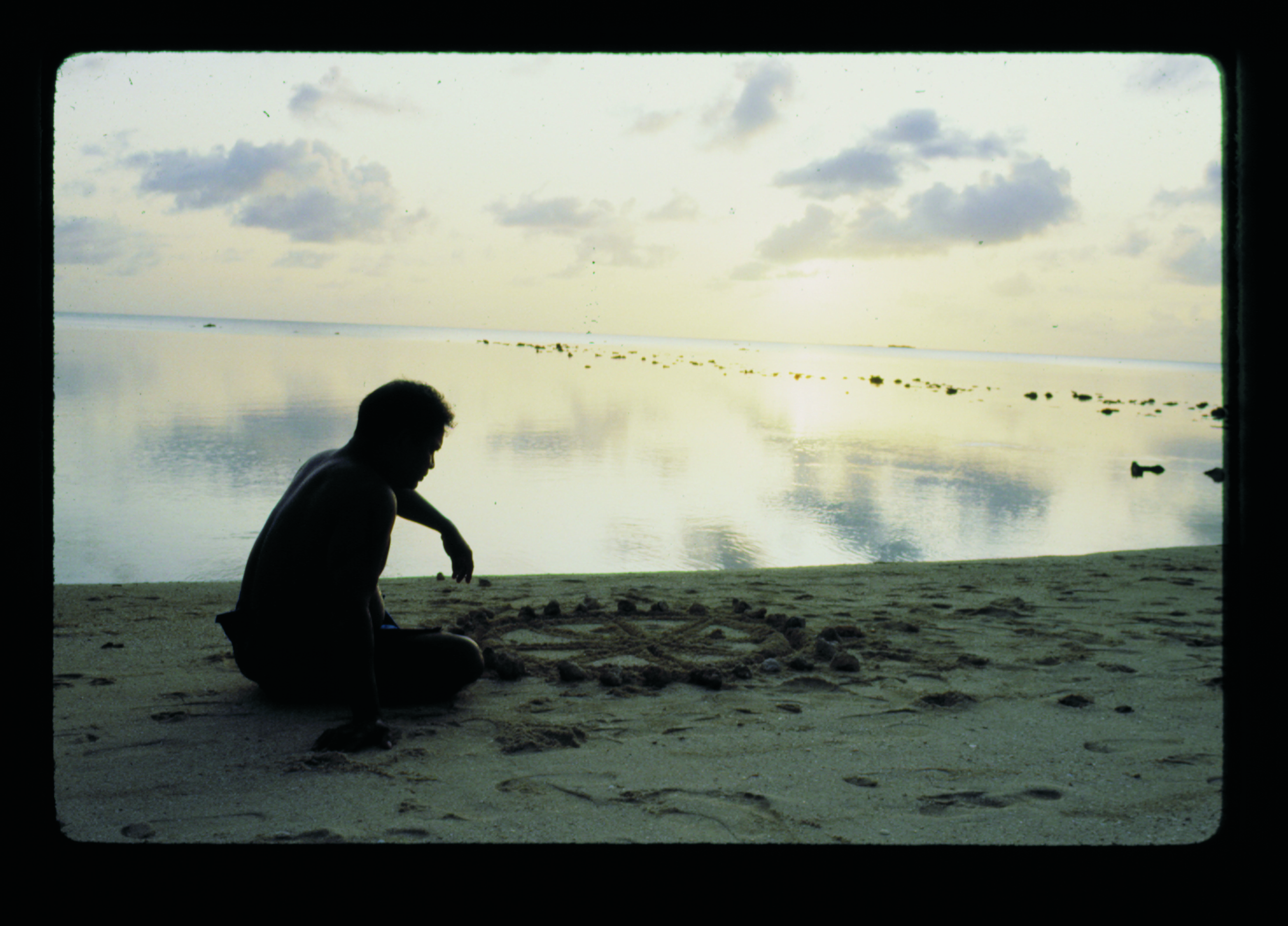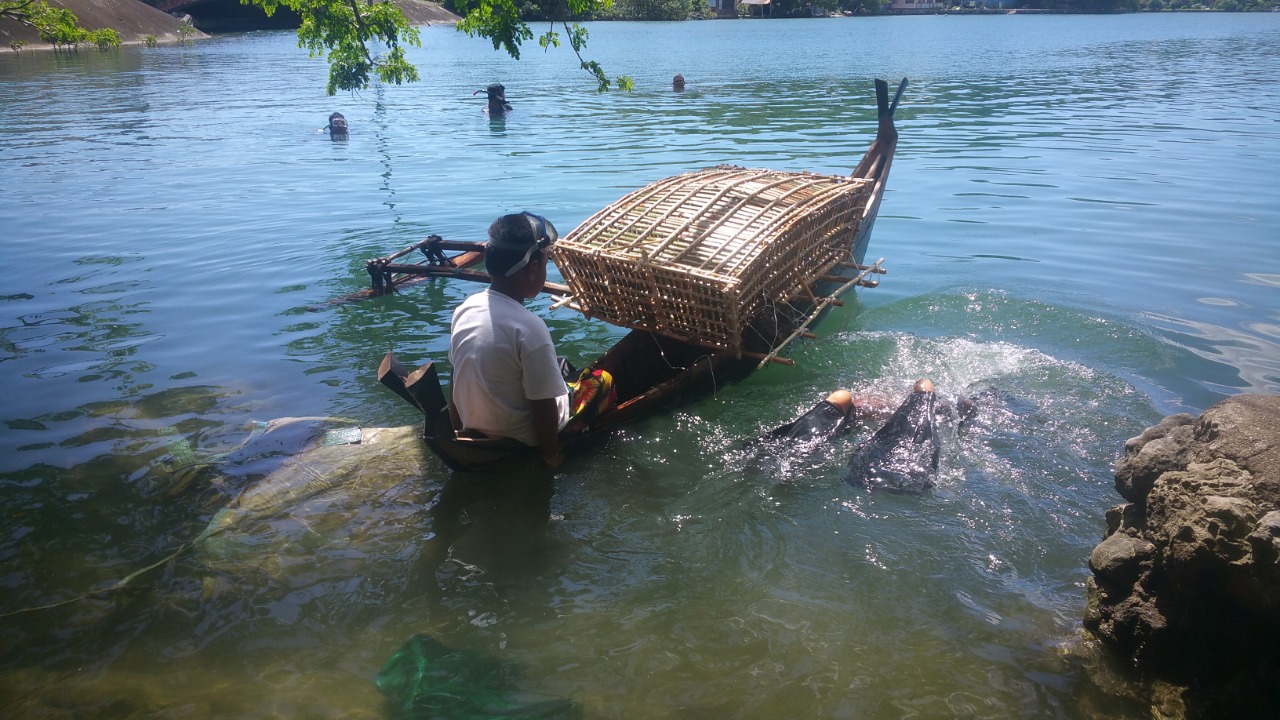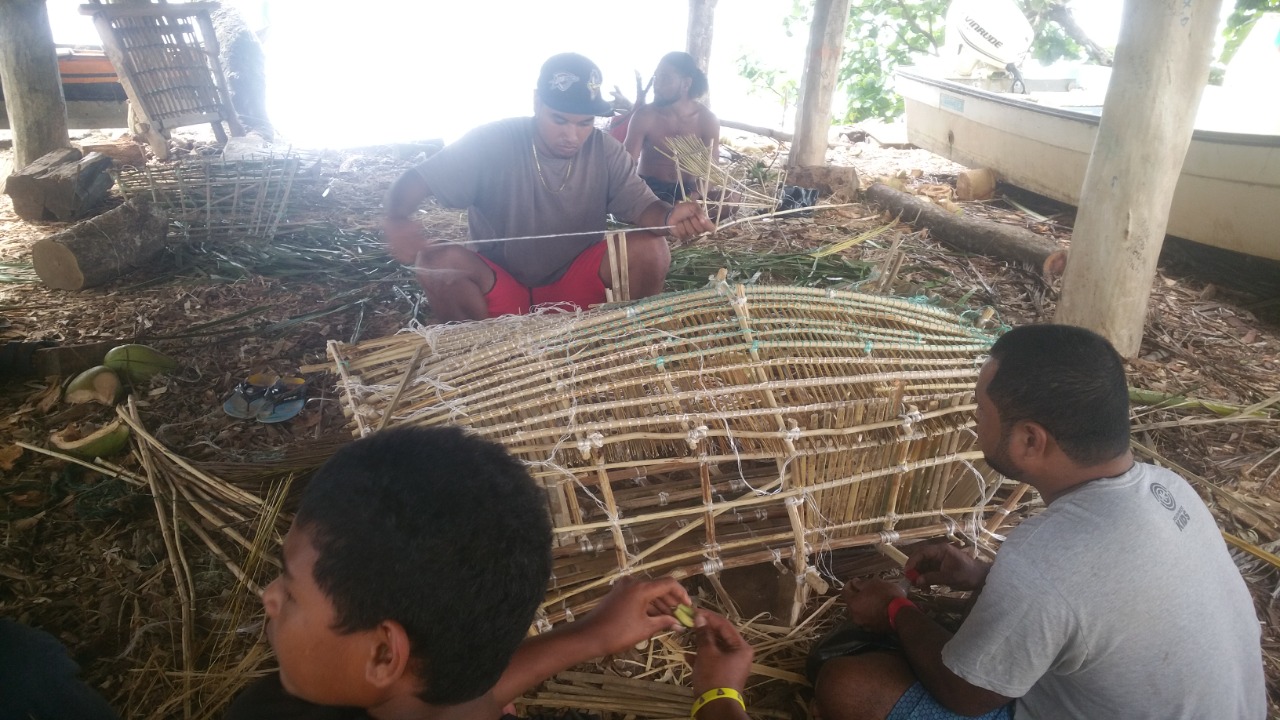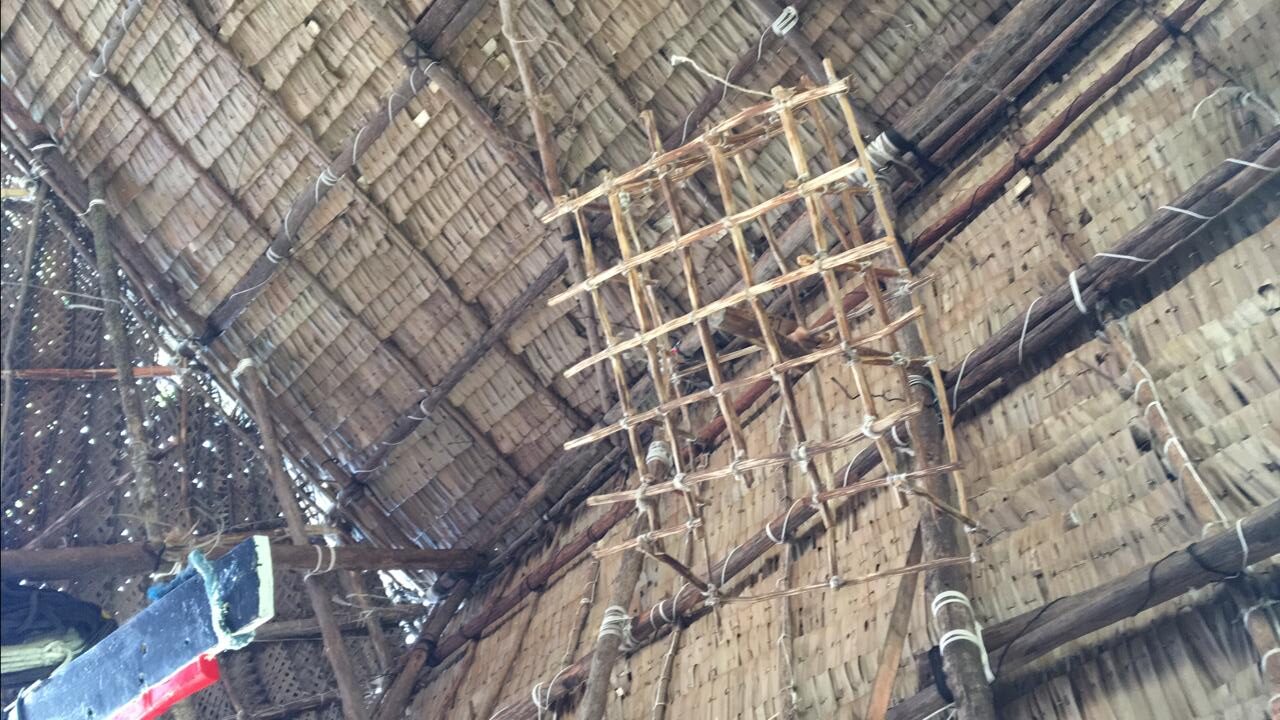Article written by H. Larry Raigetal and Amanda Millin.

Pwo navigator, Mau Piailug, draws Paafu (the Micronesian star compass) in the sand in front of a fish weir in Saipan (1983). Photo by Steve Thomas, courtesy of the Steve Thomas Traditional Micronesian Navigation Collection, 1983-1989; University of Hawaiʻi at Mānoa Library Digital Image Collections.
“Yegaleogulog sai we yan Palu sefu, me nomon unanu,
yebwe uga mo goun manewahr. rebwe la tufu naun uun Kachau”
These are opening lines of the famous Micronesian chant of Wonap, an ancestral navigator known as the father of navigation. It tells the story of how this great Palu (navigator) prepared his voyage for a distant land. His specific mission was to harvest the source of life from a fishpond using his special fish trap from the land of Kachau, a legendary place in the east where navigation originated. It is here that the skies meet the earth, and where Palulap, the patron saint of navigation, resides.
Through such historical records, we are reminded that seafarers and aquaculture practitioners have cultivated relationships over centuries. When the earliest journeyers of the wider Pacific set out on their canoes in search of new lands, they did not only equip their canoes with food and water provisions. They also carried the necessary skills and knowledge critical to the success of the voyage. Such knowledge and skills would ensure not only that populating these newfound lands was successful, but also that their people could thrive there for centuries. Core to their ways of knowing were values built into their canoe culture, including a deep respect for their surrounding environment and the resources it provided. They developed and mastered a management scheme that placed the wellbeing of the environment and its resources above community and self-interests. It was a system, designed and perfected over time, that would allow them to live in harmony with the land and the ocean.

A young apprentice in Micronesian seafaring learns how to set a nearshore fish trap using a shosemal canoe. Photo courtesy of Uncle Larry.
This canoe culture was all encompassing. It was necessary that the journeyers’ specialized skills and knowledges were interdependent. Thus, the navigators who were entrusted to lead their voyages in wayfinding were also skilled healers, builders, weavers, and fishermen, among other skill sets. They were expected to have skills that resolved issues both on land and in the ocean. After all, a navigator would not be able to practice their expertise in wayfinding without the ability to build a canoe. An understanding of trees and how to cultivate such resources was just as important. The use of the canoe to provide food, including fish, required them to be experienced in making fish traps and building fishponds and weirs. Seafarers built fish traps under the protection of the canoe house, which was located relative to the fishponds and weirs. Once finished, these traps would be dropped nearshore along the reef, in blue holes, and out in the deep sea. For seafarers in training, navigating back to where they left the fish traps would be their first test.
Looking through the lens of current mainstream society, both Indigenous aquaculture and seafaring are sustainable and adaptive examples of environmental management, literacy, and action. In March 2022, as part of a series of conversations surrounding clam gardens, members of the Clam Garden Network discussed how these spaces are keystone practices in Indigenous natural resource management that can awaken the general public and take talk into action. These words can apply to many traditional aquaculture technologies and even extend into traditional seafaring.
Individually, traditional seafaring and aquaculture each introduce the general public to specific examples of Indigenous knowledge and illustrate how these practices can be used to sustainably manage natural resources.
When paired together, traditional seafaring and aquaculture can do even more. They awaken the general public to something perhaps even more generative: interconnectivity. It is fundamentally a different way of viewing the world compared to today’s approach, which is rooted in concepts of independence, compartmentalization, and competition. Just as people are connected to one another and to the Earth, and Earth’s ecosystems are connected to one another, so too are Indigenous and traditional practices connected. Seafarers were weavers, fishpond caretakers, rock wall builders, woodcarvers, and plant medicine practitioners because that was life. Recognizing the importance of this interconnected perspective, Nainoa Thompson, founder and CEO of the Polynesian Voyaging Society, often reminds his students, “We need to transcend Western views to a worldview of those who trust nature, canoes, teachers, each other, ourselves.”
Zooming out and looking at how the skill sets embedded within traditional seafaring and aquaculture cross over and support one another also deepens the public’s ability to take talk into action.

Students studying Micronesian Seafaring under Pwo (master) navigator H. Larry Raigetal at the University of Guam make Carolinian (islands within the Federated States of Micronesia) fish traps in their boat house. Photo courtesy of Uncle Larry.
As the world faces a suite of new problems, traditional seafaring and aquaculture and their relationship to each other teach powerful ways to collectively manage nearshore to deep sea resources; consume and produce physically and spiritually nourishing marine and terrestrial foods; utilize sustainable building materials that do not rely on plastic or fossils fuels; and restore coastal habitats using important natural cues from the weather, currents, swells, flora, and fauna both on land and at sea.
Navigators utilizing both skill sets can also help re-Indigenize disaster relief. In Micronesia during an emergency, it was the responsibilty of navigators on neighboring islands to hamelau (give life). Canoes loaded with seedlings, plants, food, medicines, and other resources sailed to those in need. Once there, navigators could rely on their handiness and expertise to help rebuild houses and fishponds, administer first aid, and mobilize community members in high-stress scenarios.
In strengthening and reclaiming these skill sets and responsibilities, Pacific peoples are recovering the pride, knowledge, and ancestral vision that were taken away. And by learning how these skill sets intersect, we are doing so in the way the ancestors practiced them—together.

A Carolinian fishtrap in progress hangs from the roof of the boat house at University of Guam. Photo courtesy of Uncle Larry.
ABOUT THE AUTHOR: H. Larry Raigetal is a Pwo (master) navigator from Lamotrek, Micronesia and teaches Micronesian seafaring at University of Guam. Amanda Millin works in biocultural marine conservation in Hawaiʻi and crews with the Polynesian Voyaging Society. Both are members of the Cross-Pacific Indigenous Aquaculture Collaborative.
